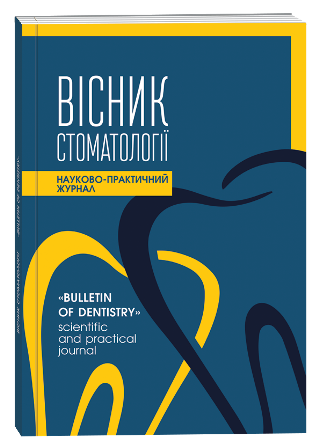MODERN ASPECTS OF THE PRINCIPLES OF ORAL CANDIDIASIS TREATMENT
DOI:
https://doi.org/10.35220/2078-8916-2025-55-1.1Keywords:
candidiasis, treatment, antifungal drugsAbstract
Purpose of the study. Fungal infection is currently a grave cause of morbidity and mortality, despite significant achievements in clinical practice and scientific research. The success of the strategy for liquidating fungal lesions of the oral mucosa is always the result of a comprehensive and multidisciplinary approach in diagnostics and treatment tactics, and requires correction of risk factors or underlying diseases, aimed at preventing candidemia and recurrent disease attacks. Research methods. With full knowledge of the arsenal of antifungal drugs, the clinician must determine the appropriate role of currently available treatment methods, the potential advantages of new antifungal drugs and the disadvantages and complications in the clinic progressing in case of candidal lesions. When using antifungal drugs, it is necessary to monitor the patient’s condition on a daily basis in order to assess the clinical effectiveness of treatment, record possible adverse reactions and determine the optimal treatment duration. Scientific novelty. When choosing a treatment regimen, the patient’s immune status, the features of oral mucosa candidiasis (clinical picture, etiology, sensitivity to antifungal drugs, positioning, process spread), and the pharmacological characteristics of available antifungal drugs (indications, metabolism, excretion, interaction with other drugs, toxicity) should be taken into account. It is recommended to prescribe general antimycotics in a clinical situation, when oral mucosa candidiasis is a consequence of the use of antibiotics, cytostatic drugs, as well as somatic diseases with immunodeficiency states and endocrinopathies. Conclusions. The effectiveness of the treatment of oral candidiasis consists in a thorough study of the past medical history and implementation of relevant recommendations. Therapy with antifungal drugs for systemic use should be prescribed only if the patient has a laboratory-confirmed/ reasonably suspected fungal infection. In order for a decision to be made on the appropriateness of starting empirical antifungal treatment, it is necessary to use methods of rapid identification of the virus.
References
Глазунов О.А., Фесенко В.І., Степанова С.В. Вивчення ефективності лікувального комплексу у хворих з кандидозним стоматитом на фоні хронічного ураження печінки. Вісник стоматології. 2023. № 121 (4). С. 22–25. doi: 10.35220/2078-8916-2022-46-4.4.
Дев’яткіна Н.М., Скрипников П.М. Скрипникова Т.П., Хміль Т.А Кандидоз порожнини рота і сучасні тенденції його раціональної фармакотерапії. Вісник проблем біології і медицини. 2022. № 1 (163). С. 22–28. DOI: 10.29254/2077-4214-2022-1-163-22-28.
Добрянський Д.О., Гуленко О.І., Знаменська Т.К., Воробйова О.В. Стандарти медичної допомоги «Інвазійний кандидоз у новонароджених дітей». Неонатологія, хірургія та перинатальна медицина. 2021. Т. 11. № 4 (42). С. 75–87. DOI: 24061/2413-4260.XI.4.42.2021.12.
Литовченко І.Ю., Ніколішина Е.В., Іленко Н.М., Марченко А.В. Застосування політерапії в місцевому лікуванні хронічного кандидозного стоматиту. Проблеми безперервної медичної освіти та науки. 2019. № 4 (36). С. 60–62. DOI: 10.31071/promedosvity2019.04.060.
Мазур І.П. Грибкові ураження слизової оболонки порожнини рота. Сучасна стоматологія. 2020. № 3. С. 72–77. DOI: 10.33295/1992-576Х-2020-3-72.
Мокія-Сербіна С.О., Фесенко В.І. Орофарингеальний кандидоз – міждисциплінарні аспекти медицини дитинства. Здоров’я дитини. 2024. Т. 19. № 4. С. 116–125. DOI: 10.22141/2224-0551.19.4.2024.1711.
Про затвердження Стандарту медичної допомоги «Раціональне застосування антибактеріальних і антифунгальних препаратів з лікувальною та профілактичною метою» : наказ МОЗ України від 23.08.2023 р. № 1513. URL: https://moz.gov.ua.
Скрипнікова Т.П., Ступак О.П., Левицький А.Р. та ін. Дисбіоз порожнини рота: проблема та вирішення. Український журнал дерматології, венерології, косметології. 2018. № 1. С. 42–47. URL: http://nbuv.gov.ua/UJRN/Ujdvc_2018_1_8.
Стоматологія : підручник / М.М. Рожко та ін. ; за ред. М.М. Рожка. Київ : ВСВ «Медицина», 2018. 467 с.
Терлецький Р.В. Ефективність та безпечність застосування спрея Стоматофіту А міні порівняно із загальноприйнятими засобами при стоматитах у дітей. Сучасна педіатрія. 2019. № 1 (97). С. 132–136. Doi: 10.15574/SP.2019.97.132.
Фесенко В.І., Глазунов О.А. Кандидоз порожнини рота: діагностика і лікування : навчальний посібник. Дніпро ; Львів : Видавництво ПП «Новий світ – 2000», 2023. 235 с.
Ardizzoni A., Boaretto G., Pericolini E., Pinetti D., Capezzone de Joannon A., Durando L., Ragni L., Blasi E. Effects of benzydamine and mouthwashes containing benzydamine on Candida albicans adhesion, biofilm formation, regrowth, and persistence. Clin Oral Investig. 2022. № 26 (4). Р. 3613–3625. doi: 10.1007/s00784-021-04330-8.
Darwazeh Azmi M.G., Darwazeh Tamer A. What Makes Oral Candidiasis Recurrent Infection? A Clinical View. Journal of Mycology. 2014. URL: https://doi.org/10.1155/2014/758394.
Carmo P.H.F.D., Garcia M.T., Figueiredo-Godoi L.M.A., Lage A.C.P., Silva N.S.D., Junqueira J.C. Metal Nanoparticles to Combat Candida albicans Infections: An Update. Microorganisms. 2023. Vol. 11 (1). P. 138. doi: 10.3390/microorganisms11010138.
Di Cosola M., Cazzolla A.P., Charitos I.A., Ballini A., Inchingolo F., Santacroce L. Candida albicans and Oral Carcinogenesis : A Brief Review. J. Fungi. 2021. Vol. 7 (6). Р. 476. URL: https://doi.org/10.3390/jof7060476.
Guarner F., Sanders M.E., Szajewska H. et al. Probiotics and prebiotics WGO Global Guideline. World Gastroenterology Organisation. 2023. URL: https://www.worldgastroenterology.org/guidelines/probiotics-andprebiotics.
Quindós G., Gil-Alonso S., Marcos-Arias C. et al. Therapeutic tools for oral candidiasis: Current and new antifungal drugs. Med Oral Patol Oral Cir Bucal. 2019. № 1. Т. 24 (2). Р. e172–180. doi: 10.4317/medoral.22978.
Kuunda S., Adeoti K., Munir M., Giusti Al., Refinetti P., Otu A. et al. Application of probiotic-based multicomponents for human, animal and ecosystem health: concepts, methodologies and mechanisms of action. Microorganisms. 2022. № 10 (9). Р. 1700. URL: https://doi.org/10.3390/microorganisms10091700.
Lewis M.A.O., Williams D.W. Diagnosis and management of oral candidosis. Br Dent J. 2017. Vol. 223 (9). P. 675–681. doi: 10.1038/sj.bdj.2017.886.
Medina-Ramírez I.E., de León-Macias C.E.D., Pedroza-Herrera G., Gonzáles-Segovia R. Evaluation of the biocompatibility and growth inhibition of bacterial biofilms by ZnO, Fe3O4 and ZnO Fe3O4 photocatalytic magnetic materials. J. Сeramint. 2020. Vol. 46. P. 8979–8994. DOI: 10.1016/j.ceramint.2019.12.145.
Mueller S.W., Kedzior S.K., Miller M.A., Reynolds P.M., Kiser T.H., Krsak M., Molina K.C. An overview of current and emerging antifungal pharmacotherapy for invasive fungal infections. Expert Opin Pharmacother. 2021. Vol. 22 (10). P. 1355–1371. doi: 10.1080/14656566.2021.1892075.
Pappas P.G., Kauffman C.A., Andes D.R. et al. Clinical Practice Guideline for the Management of Candidiasis: 2016 Update by the Infectious Diseases Society of America. Clin Infect Dis. 2016. Vol. 62 (4). P. e1 – e50. DOI: 10.1093/cid/civ933.
Pelgrift R.Y., Friedman A.J. Nanotechnology as a therapeutic tool to combat microbial resistance. Adv. Drug Deliv. Rev. 2013. Vol. 65. P. 1803–1815. URL: https://doi.org/10.1016/j.addr.2013.07.011.
Poissy J., Damonti L., Bignon A., Khanna N., Von Kietzell M. et al. Risk factors for candidemia: a prospective matched case-control study. Crit Care. 2020. Vol. 24. P. 109–120. DOI: 10.1186/s13054-020-2766-1.
Reinhardt L.C., Nascente P.S., Ribeiro J.S. et al. A single-center 18-year experience with oral candidiasis in Brazil: a retrospective study of 1,534 cases. Braz. Oral Res. 2018. Vol. 32. P. 92. doi: 10.1590/1807-3107bor2018.vol32.0092.
Revie N.M., Iyer K.R., Robbins N., Cowen L.E. Antifungal Drug Resistance: Evolution, Mechanisms and Impact. Curr. Opin. Microbiol. 2018. Vol. 45. P. 70–76. DOI: 10.1016/j.mib.2018.02.005.
Rodrigues C.F., Rodrigues M.E., Henriques M. Candida sp. Infections in Patients with Diabetes Mellitus. J. Clin Med. 2019. Vol. 8 (1). Р. 76. doi: 10.3390/jcm8010076.
Schoenenberger-Arnaiz J.A., Aragones-Eroles A., Taberner-Bonastre P. et al. Therapeutic drug monitoring in fungal infections: The dawn of proactive monitoring. A narrative review. Biomed Res Clin Prac. 2021. Vol. 6. P. 2–7. DOI: 10.15761/BRCP.1000223.
Yadav M.K., Kumari I., Singh B. et al. Probiotics, prebiotics and synbiotics: Safe options for next-generation therapeutics. Appl Microbiol. Biotechnol. 2022. № 106 (2). Р. 505–521. doi: 10.1007/s00253-021-11646-8.









